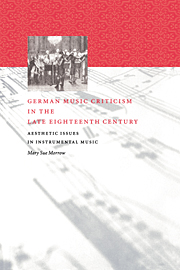Book contents
- Frontmatter
- Contents
- Acknowledgments
- Author's note
- Introduction: terms of discourse
- 1 What does instrumental music mean?
- 2 Answering with a unified voice
- 3 Answering with a German voice
- 4 Answering with aesthetic criteria
- 5 The importance of being correct
- 6 The reign of genius
- 7 A call to order
- 8 Epilogue: segue to the nineteenth century
- Notes
- Bibliography
- Index
4 - Answering with aesthetic criteria
Published online by Cambridge University Press: 03 October 2009
- Frontmatter
- Contents
- Acknowledgments
- Author's note
- Introduction: terms of discourse
- 1 What does instrumental music mean?
- 2 Answering with a unified voice
- 3 Answering with a German voice
- 4 Answering with aesthetic criteria
- 5 The importance of being correct
- 6 The reign of genius
- 7 A call to order
- 8 Epilogue: segue to the nineteenth century
- Notes
- Bibliography
- Index
Summary
Altonaischer gelehrter Mercurius (1779), review of the anonymous pamphlet Wahrheiten die Musik betreffend, gerade herausgesagt von einem deutschen Biedermann.
We would like to take the liberty – which the author himself takes – to say bluntly that he knows little or nothing about the art of which he speaks; that nearly everything he says is nothing but hogwash; and that other people should be writing truths about an art whose aesthetic is unfortunately still so little known.
Allgemeine deutsche Bibliothek (1786): Louis Abeille, Deux Sonates.
You won't find any new ideas here, and even the well-digested ones are always found in the most beautiful – disorder – so that we can scarcely expect to have a theory of musical aesthetics from Herr A.
As the review collective busied itself with defining and encouraging true German instrumental music, lively debates were occurring in literature, philosophy, and the other arts, debates that would provide aesthetic criteria to fill the void left by the rejection of mimesis. Reviewers soon joined in, but they did not simply tag along behind the leading edge of the discourse, gleaning whatever ideas they found useful: they participated fully, contributing their opinions and perspectives, and sometimes even anticipating issues that later achieved general aesthetic significance. This intersection with non-musical thought collectives – facilitated by the reviews' presence in general readership journals – reflected the interdisciplinary nature of German thought in the last quarter of the century.
- Type
- Chapter
- Information
- German Music Criticism in the Late Eighteenth CenturyAesthetic Issues in Instrumental Music, pp. 66 - 78Publisher: Cambridge University PressPrint publication year: 1997



